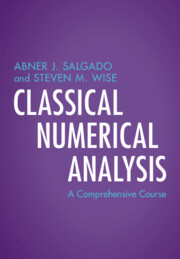Book contents
- Frontmatter
- Contents
- Preface
- Acknowledgements
- Symbols
- Part I Numerical Linear Algebra
- Part II Constructive Approximation Theory
- Part III Nonlinear Equations and Optimization
- Part IV Initial Value Problems for Ordinary Differential Equations
- 17 Initial Value Problems for Ordinary Differential Equations
- 18 Single-Step Methods
- 19 Runge–Kutta Methods
- 20 Linear Multi-step Methods
- 21 Stiff Systems of Ordinary Differential Equations and Linear Stability
- 22 Galerkin Methods for Initial Value Problems
- Part V Boundary and Initial Boundary Value Problems
- Appendix A Linear Algebra Review
- Appendix B Basic Analysis Review
- Appendix C Banach Fixed Point Theorem
- Appendix D A (Petting) Zoo of Function Spaces
- References
- Index
20 - Linear Multi-step Methods
from Part IV - Initial Value Problems for Ordinary Differential Equations
Published online by Cambridge University Press: 29 September 2022
- Frontmatter
- Contents
- Preface
- Acknowledgements
- Symbols
- Part I Numerical Linear Algebra
- Part II Constructive Approximation Theory
- Part III Nonlinear Equations and Optimization
- Part IV Initial Value Problems for Ordinary Differential Equations
- 17 Initial Value Problems for Ordinary Differential Equations
- 18 Single-Step Methods
- 19 Runge–Kutta Methods
- 20 Linear Multi-step Methods
- 21 Stiff Systems of Ordinary Differential Equations and Linear Stability
- 22 Galerkin Methods for Initial Value Problems
- Part V Boundary and Initial Boundary Value Problems
- Appendix A Linear Algebra Review
- Appendix B Basic Analysis Review
- Appendix C Banach Fixed Point Theorem
- Appendix D A (Petting) Zoo of Function Spaces
- References
- Index
Summary
We motivate the introduction of multistep schemes by recalling interpolatory quadrature rules. Then, these are presented in the general setting. Their consistency and conditions of consistency: the method of C’s and the log method are discussed. The construction and consistency of Adams-Bashforth, Adams-Moulton, and backward differentiation formulas is then presented. Then, we turn our attention to the delicate issue of stability for multistep schemes: the notions of zero stability, root condition, and homogeneous zero stability are introduced and their equivalence discussed. This is achieved by developing the theory of solutions to linear difference equations. The celebrated Dahlquist equivalence theorem, stating that a linear multistep scheme is convergent if and only if it is consistent and stable is then presented. A discussion of Dahlquist first barrier concludes the chapter
Keywords
Information
- Type
- Chapter
- Information
- Classical Numerical AnalysisA Comprehensive Course, pp. 555 - 580Publisher: Cambridge University PressPrint publication year: 2022
